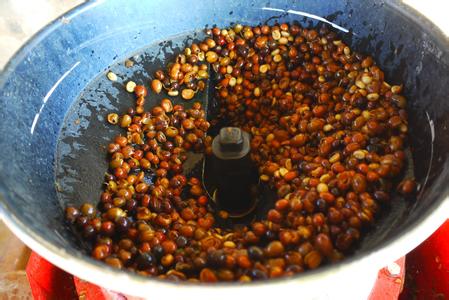El Salvador Himalayan Coffee Flavor description by hand method
El Salvador Himalayan Coffee Flavor description by hand method
El Salvador is washed beans, medium-shallow baked, warm and smooth, smooth entrance, sweet and sour mellow thickness are very regular, do not have too prominent flavor characteristics, so do not leave much impression. But the flavor of the tanned El Salvador becomes very recognizable and amazing.
Salvadoran coffee inherits the mild quality of Sino-American coffee, which is soft, slightly sour and has a beautiful sweetness. At the same time, it also has its own characteristics: the aromatic taste is slightly sour and very soft; it is pure and has no miscellaneous flavor, and the taste balance is excellent; the smooth feeling like cream chocolate is impressive; the dense feeling of coffee in the mouth gives the coffee a deep taste and a long finish.
The coffee beans from the estate are washed at Mauricio Salaverria's El Divisadero processing plant in Ataco, and then evenly dried in an African elevated shed bed with the help of sun and ventilation. Following the career of his parents and grandparents, Mauricio has been associated with coffee since childhood, especially focusing on the cultivation of boutique coffee
Coffee fields are endless, and most of them are harvested by machinery, which is in line with economic benefits. When 75% of the coffee fruit in the coffee garden turns red, mechanical harvesting is started, followed by the same pre-washing operation, which is moved into the sink to remove floating beans, sift out the sunken beans, and then use a large pulp screening machine to dig out the pulp and remove the pods covered with pectin. The next stage is separate from the washing method: the sticky pods do not need to be moved into the tank to ferment, but to the outdoor bean drying farm. Because of the dry climate in Brazil, the sticky pectin on the pods will harden in about a day or so. Then use a large number of manpower to turn up and down to make the pods dry evenly inside and outside, so as not to return to moisture and stink.

Important Notice :
前街咖啡 FrontStreet Coffee has moved to new addredd:
FrontStreet Coffee Address: 315,Donghua East Road,GuangZhou
Tel:020 38364473
- Prev

What kind of coffee is aricha washed with aricha?
What kind of coffee is aricha washed aricha? there are many high-quality coffee processing plants in Yejasuefi area. A lot of caffeine comes from these processing plants and becomes worth a hundred times as much. The tuition fee for tanning produced by Kebel Aricha Mill is one of them. This kind of coffee is also what we often call ARICHA beans. It is determined by ECX after being treated by the Kebel Aricha processing plant through exquisite sun treatment.
- Next

Flavor characteristics of Costa Rican Yellow Honey Coffee A brief introduction to the region produced by price treatment
The flavor characteristics of Costa Rican yellow honey coffee A brief introduction to the production area of price treatment honey treatment keeps the coffee washed clean, although the brightness of the coffee decreases, it increases the sweetness and caramel taste. According to the different degree of honey treatment, honey-treated coffee is divided into yellow honey treatment, red honey treatment and black honey treatment in the treatment of raw coffee beans.
Related
- Detailed explanation of Jadeite planting Land in Panamanian Jadeite Manor introduction to the grading system of Jadeite competitive bidding, Red bid, Green bid and Rose Summer
- Story of Coffee planting in Brenka region of Costa Rica Stonehenge Manor anaerobic heavy honey treatment of flavor mouth
- What's on the barrel of Blue Mountain Coffee beans?
- Can American coffee also pull flowers? How to use hot American style to pull out a good-looking pattern?
- Can you make a cold extract with coffee beans? What is the right proportion for cold-extracted coffee formula?
- Indonesian PWN Gold Mandrine Coffee Origin Features Flavor How to Chong? Mandolin coffee is American.
- A brief introduction to the flavor characteristics of Brazilian yellow bourbon coffee beans
- What is the effect of different water quality on the flavor of cold-extracted coffee? What kind of water is best for brewing coffee?
- Why do you think of Rose Summer whenever you mention Panamanian coffee?
- Introduction to the characteristics of authentic blue mountain coffee bean producing areas? What is the CIB Coffee Authority in Jamaica?

